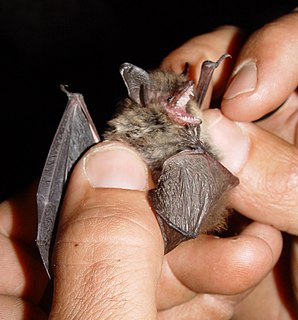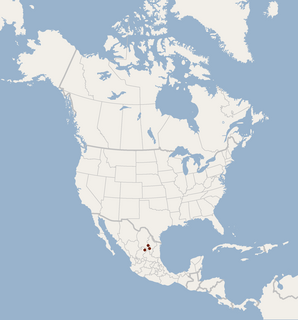
The mouse-eared bats are a diverse and widespread genus (Myotis) of bats within the family Vespertilionidae.

The Japanese house bat or Japanese pipistrelle is a species of vesper bat. An adult has a body length of 3.6–4.8 cm (1.4–1.9 in), a tail of 2.9–4.0 cm (1.1–1.6 in), and a wing length of 3.2–3.6 cm (1.3–1.4 in). It prefers to roost under the ceiling or inside the roof of old buildings. It is found across East Asia, from China and Taiwan into the Ussuri region, the Korean Peninsula, and Japan.

The little goblin bat is a species of bat in the family Molossidae, the free-tailed bats. It is endemic to Cuba.
New Caledonia wattled bat(Chalinolobus neocaledonicus) is a species of vesper bat in the genus Chalinolobus. It is found only in New Caledonia.

Allen's yellow bat is a species of vesper bat. There is some taxonomic debate surrounding this species, with some authors considering Baeodon a genus rather than a subgenus. It is endemic to Mexico.

Nyctophilus geoffroyi is a vespertilionid bat, a flying nocturnal mammal found in Australia, The species is relatively common. They have been referred to as the lesser long-eared bat.

The big-eared pipistrelle is a species of vesper bat in the family Vespertilionidae. It can be found in Indonesia and Malaysia. It forages over mud flats over Peninsula Malaysia but its roosting activities are unknown. Its habitat is being threatened by deforestation for agriculture, plantations, logging and fires but how it affects this bat or if it is adaptable are unknown.

Myotis fimbriatus is a species of vesper bat in the family Vespertilionidae. It is found only in China. It's also called the fringed long-footed myotis. The fringed long-footed myotis is described as having short, thick, brown fur with pale whitish fur ventrally. A captured female was measured with ears that were 14.4 mm long, a forearm 42.2 mm long, and a weight of 9.9 grams. Myotis fimbriatus is listed as being of least concern by the IUCN as of 2008. In 2000, Myotis fimbriatus was listed as being "lower risk/near threatened".

The flat-headed myotis is a species of vesper bat. It is endemic to Mexico where it is found in certain montane forests in the Sierra Madre Oriental in the northeast of the country. Once thought to be extinct, this bat was rediscovered in 2004 by Joaquín Arroyo-Cabrales and colleagues. The species is now classified as endangered by the IUCN.
The inland forest bat is a vespertilionid bat that occurs in central and arid regions in Australia. They were first described in 1987, published in a review of poorly surveyed microbat populations. A tiny flying mammal, whose body is around twelve millimetres (½ inch) long, that occupies small cavities in trees and buildings while roosting. The nocturnal activity is foraging for insects, typically moths.

The blunt-eared bat or Peruvian crevice-dwelling bat is a species of bat in the family Molossidae. It is monotypic within the genus Tomopeas and subfamily Tomopeatinae. It is endemic to Peru, where it is considered critically endangered. It is threatened by habitat loss.

The Sardinian long-eared bat is a species of bat endemic to Sardinia, Italy.

Pipistrellus raceyi, also known as Racey's pipistrelle, is a bat from Madagascar, in the genus Pipistrellus. Although unidentified species of Pipistrellus had been previously reported from Madagascar since the 1990s, P. raceyi was not formally named until 2006. It is apparently most closely related to the Asian species P. endoi, P. paterculus, and P. abramus, and its ancestors probably reached Madagascar from Asia. P. raceyi has been recorded at four sites, two in the eastern and two in the western lowlands. In the east, it is found in open areas and has been found roosting in a building; in the west it occurs in dry forest. Because of uncertainties about its ecology, it is listed as "Data Deficient" on the IUCN Red List.

Gallagher's free-tailed bat is a free-tailed bat endemic to the Democratic Republic of the Congo. Only one individual has ever been documented.

The Annamit myotis is a species of mouse-eared bat in the family Vespertilionidae, described in 2001, and indigenous to the Minh Hóa Districton the northern coast of Vietnam. Following its description, investigators succeeded in locating M. annamiticus only in Phong Nha-Kẻ Bàng National Park, and the data regarding the distribution, population, and range of the species is otherwise inadequate to determine its conservation requirements. However it is protected by Phong Nha-Kẻ Bàng National Park.

The long-toothed pipistrelle is a species of bat of the genus Hypsugo. It is a small bat, with a length of 35.2–38.4 mm of forearm, and 5.9–7 mm of foot. It feeds on insects and has especially long canines compared to others of its genus.
The Taiwan broad-muzzled myotis is a species of vesper bat found in Taiwan.

Nyctophilus major, referred to as a western long-eared bat, is a species found in forests and woodlands of Southwest Australia.
Neoromicia stanleyi, also called Stanley's serotine, is a species of vesper bat in the genus Neoromicia. It is found across southern Africa. The species was formerly known as N. cf. melckorum, before being named as a species in 2017.
Pipistrellus dhofarensis is a species of vesper bat in the genus Pipistrellus. It is found in Southern Arabia, including Oman and Yemen.













